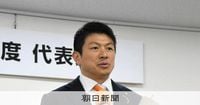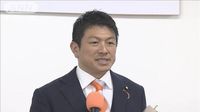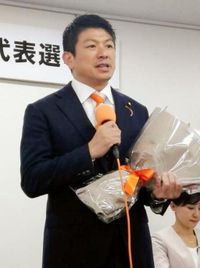On May 9, 2025, the Sanseito party held an extraordinary party convention at its headquarters in Tokyo, marking a significant milestone as it conducted its first representative election since its formation. The incumbent, Sohei Kamiya, aged 47, successfully secured re-election, defeating fellow candidates Rina Yoshikawa, a 37-year-old member of the House of Representatives, and Yuichiro Kawa, a 53-year-old deputy representative from Ishikawa Prefecture.
The election results revealed a decisive victory for Kamiya, who garnered 169 votes, while Yoshikawa received 45 votes and Kawa obtained 36 votes. This election was particularly noteworthy as it aimed to enhance transparency within the party's electoral processes, which had previously relied on a majority decision from the standing officers' meeting based on party regulations.
Kamiya, who first entered national politics through the House of Councillors election in 2022 and has served as the party's representative since August 2024, expressed his gratitude during a press conference following the election. "I have received the trust of many people. I am very grateful and feel a sense of responsibility," he stated, emphasizing the importance of voter confidence.
During his address, Kamiya outlined his ambitious goals for the upcoming summer Upper House election, stating, "I want to increase the number of votes more than ever before." He underscored the party's commitment to reducing taxes, specifically focusing on the abolition of the consumption tax. Kamiya articulated a clear target for the election: to secure six seats in total, consisting of one in the electoral district and five through proportional representation.
The Sanseito party, established in 2020, has made significant strides since its inception, including a notable performance in the 2024 House of Councillors election, where it achieved three proportional representation seats. As the party gears up for the summer elections, the focus will be on voter engagement and policy advocacy.
In the lead-up to the election, the party conducted street speeches and discussion meetings across nine prefectures, including major urban centers like Tokyo, Osaka, and Fukuoka. This grassroots approach aimed to foster dialogue and connect directly with constituents, ensuring that the party's message resonated with the electorate.
Kamiya's re-election and the party's strategic focus on tax reduction reflect a broader trend in Japanese politics where economic issues remain at the forefront of voter concerns. As the summer elections approach, the Sanseito party is poised to leverage its recent successes and the trust placed in its leadership to campaign vigorously.
Looking ahead, the Sanseito party's agenda will likely continue to emphasize economic reform and the reduction of the national burden on citizens. Kamiya's vision for the party includes not only a commitment to fiscal responsibility but also a desire to enhance the party's visibility and impact within Japan's political landscape.
As the political climate evolves, the Sanseito party's strategies and policies will be closely scrutinized by both supporters and opponents. With the recent election results providing a mandate for Kamiya's leadership, the party is expected to navigate the upcoming electoral challenges with renewed vigor and a clear focus on its objectives.
In summary, the Sanseito party's first representative election has set the stage for an important summer campaign, with Sohei Kamiya at the helm. His commitment to increasing voter turnout and addressing key economic issues will be pivotal as the party seeks to expand its influence and achieve its electoral goals.






